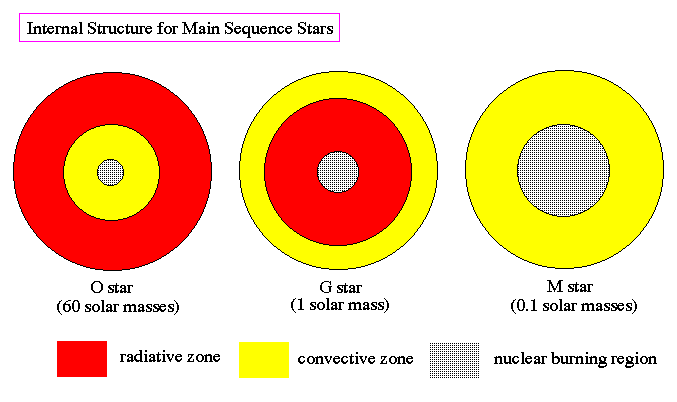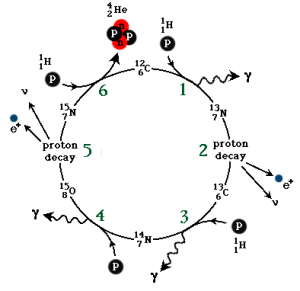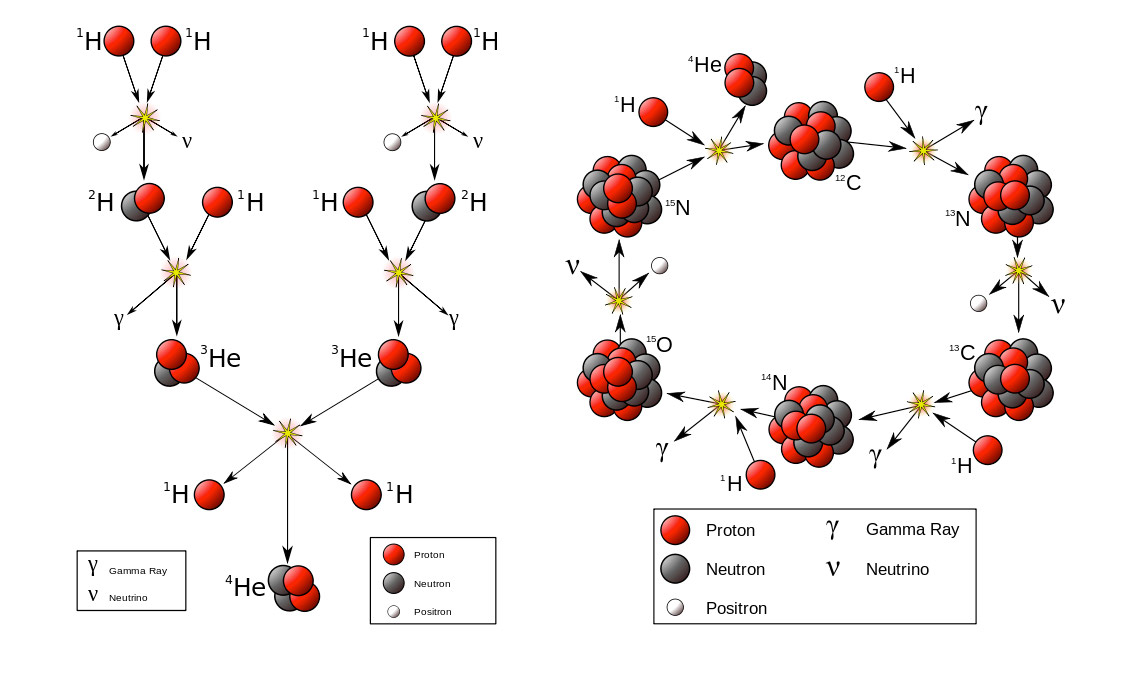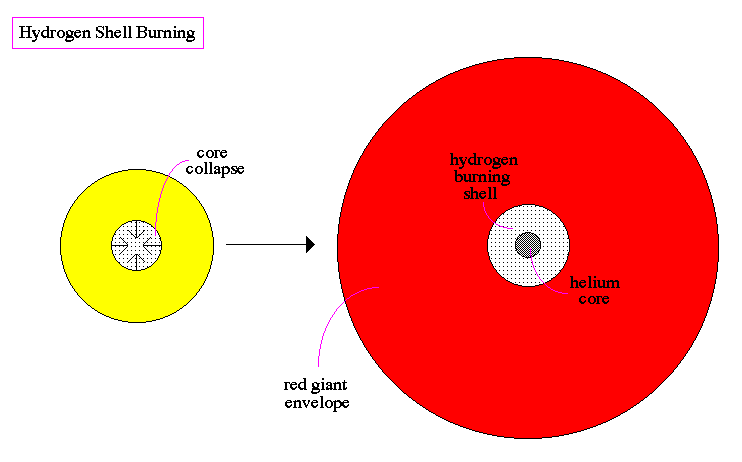
|
Main Sequence Stars:
| Readings: Schneider & Arny: Units 59, 61 |
| (Audio Lecture) |
Once a protostar starts burning hydrogen in its core, it quickly passes through the T-Tauri stage (in a few million years) and becomes a main sequence star where its total mass determines all its structural properties. The three divisions in a stellar interior are the nuclear burning core, convective zone and radiative zone. Energy, in the form of gamma-rays, is generated solely in the nuclear burning core. Energy is transfered towards the surface either in a radiative manner or convection depending on which is more efficient at the temperatures, densities and opacities.
The interior of three stellar types are shown below. Note that an O star is about 15 larger than a G star, and a M star is about 1/10 the size of a G star, this scale is shown below the interiors.


Notice how the nuclear burning regions takes up a larger percentage of the stellar interior as one goes to low mass stars. High mass stars have a very small core surrounded by a large envelope. The energy released from the stellar core heats the stellar interior producing the pressure that holds a star up.
If stars were like cars, then they would burn their core hydrogen until they ran out and the star would fade out. But fusion converts hydrogen into helium. So the core does not become empty, it fills with helium `ash'.

As the helium ash builds up, energy generation stops in the core. The fusion process moves outward into a shell surrounding the hot helium core. Helium can also undergo fusion but, since it is a larger atom, it requires over a 100 million degrees of temperature to overcome its electrostatic repulsion (the helium nuclei has two protons, double the hydrogen nuclei). For small stars, this temperature is never reached and the helium core remains inert.
Stars begin their lives as 74% hydrogen, 25% helium and 1% everything else on the periodic table (by mass). Fusion has been ongoing in the core of the Sun for 5 billion years, and its core is now about 29% hydrogen, 70% helium and 1% everything else. Fusion alters the chemical composition of stellar interiors.
Note that since the cores of stars are so large and massive, it takes anywhere from 100's of thousands to billions of years to run out of hydrogen fuel. Clearly, stars that burn brightest, burn fastest and, thus, have the shortest lifetimes.
We can use Einstein's famous E=mc2 to find out how long before a star evolves into a red giant star. The total energy released by a star in its lifetime is, E*, such that:
where L is the luminosity of the star (energy per sec) and t is the lifetime of the star. The total energy produced by a star is how much of the star's mass is converted into energy. Assuming that about 1/2 mass of the star is passed through the fusion reaction in the core, which converts 0.71% of the mass of four protons into energy. Thus, with E=mc2, we get:
where M is the mass of the star. So the lifetime of a star, t, in seconds is
Now we know from the mass-luminosity relation for stars that L α M3.5 so:
t α c2/M2.5
in terms of solar units we have
where Mo is the mass of the Sun and to is the lifetime of the Sun, 1010 years. So we see that a massive, hot star burns fast (short lifetime) and a low mass, cool star burns slow.

CNO Cycle:
The proton-proton chain is the main source of energy for main sequence stars. However, for star more massive than the Sun, another process can also generate energy, hydrogen fusion by the carbon cycle known as the CNO cycle. The CNO cycle uses carbon (C), nitrogen (N) and oxygen (O) as catalysts for the production of helium (He). CNO are much larger atoms than H or He and can form into various isotopes. An isotope is a nuclei which is rich or deficient in the number of neutrons. The number of protons determines the element name, carbon as 6 protons, nitrogen has 7, oxygen has 8. Normal carbon has an equal number of neutrons to make the nuclei of carbon 6 protons plus 6 neutrons = carbon-12. Atomic notation is such that:

An extra neutron to make the isotope carbon-13 increases the atomic mass to 13, but the element is still carbon (i.e. 6 protons). The CNO cycle is basically the fusion of protons by carbon-12 nuclei until they work their way up the periodic table to nitrogen-15 where the fusion of a proton produces a He nuclei and carbon-12 (back to start).

Notice that along the way various positrons, neutrinos and gamma-rays are produced as the decay products from the unstable isotopes. These are the source of energy in addition to the proton-proton chain gamma-rays.
| 12C6 + 1H1 |

| 13 N 7 + γ |
| 13 N 7 |

| 13 C 6 + e+ + ν |
| 13 C 6 + 1 H 1 |

| 14 N 7 + γ |
| 14 N 7 + 1 H 1 |

| 15 O 8 + γ |
| 15 O 8 |

| 15 N 7 + e+ + ν |
| 15 N 7 + 1 H 1 |

| 12 C 6 + 4 He 2 |

Post-Main Sequence Evolutionary Tracks:
As the supply of hydrogen in the core begins to decreases, the fusion rate goes down, and the amount of energy generated drops. From thermal equilibrium we know that the temperature will then begin to drop and then the pressure will also decrease in the fusion core.
From hydrostatic equilibrium, we know that a drop in pressure means that the core region of the star will contract slightly. This will cause the temperature to go up again, and the fusion rate, for the remaining hydrogen in the core, jumps up (even though the core hydrogen is almost gone (a last gasp). The sharp rise in temperature also starts a hydrogen burning shell around the core, a region that before was too cool (less than 15 million degrees) to sustain fusion before. At this point, the hydrogen burning shell becomes important as the sole source of energy in the dying star.
Once the hydrogen burning shell is created, the star makes a small jump off the main sequence in the HR diagram. It becomes slightly brighter and slightly cooler. The drop in surface temperature is because the envelope of the star expands a small amount, increasing the surface area. This increased surface area also increases the luminosity of the star.
Once the last of the hydrogen is used up in the core of an aging main sequence star, fusion stops in the core and the temperature drops and the core collapses. The collapsing core converts gravitational energy (potential energy) into thermal energy (kinetic energy). This energy is directed into the hydrogen burning shell, which expands to consume more fuel in the star's interior.

The hydrogen burning shell generates more energy than the core did (it has access to a much larger volume of the star's mass) and the star increases sharply in luminosity and expands in size to become a red giant. Even though the star is brighter, produces more energy, its pressure has increased such that its surface area has become very large, and the surface temperature of the star drops into the K and M spectral type regions.

This whole process takes several million years but, in the end, the main sequence star becomes either a red supergiant or a red giant, depending on its initial mass. Notice that where and how fast a star evolves is determined by its main sequence mass. Hot, massive O stars age quickly and become red supergiants. Cooler, less massive G stars live for 10 billion years, then evolve into red giants.
Notice also that we do not see evolutionary tracks for stars less than 0.8 solar masses. This is because the time for those types of stars to evolve into red giants is longer than the current age of the Universe (about 15 billion years). So even if a star was born right at Creation, there has not been enough time for a star with that low a mass to use up all its hydrogen fuel. In fact, we know the lower limit to the age of the Universe by looking at the masses of red giants, to see what are the oldest stars.

|
|

|